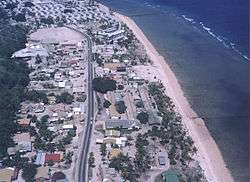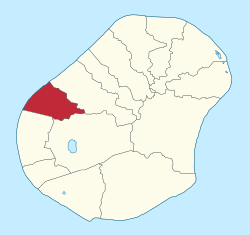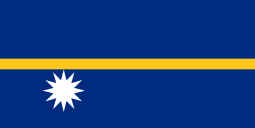Denigomodu District
Denigomodu is a district in the western part of the island of Nauru. It is the most populous district in Nauru.
Denigomodu | |
|---|---|
District | |
 View of Denigomodu and Nibok | |
 Denigomodu District within Nauru | |
| Coordinates: 0°31′25″S 166°54′52″E | |
| Country | |
| Constituency | Ubenide |
| Area | |
| • Total | 0.9 km2 (0.3 sq mi) |
| Elevation | 20 m (70 ft) |
| Population (2011) | |
| • Total | 307 |
| • Density | 2,004/km2 (5,190/sq mi) |
| Time zone | (UTC+12) |
| Area code(s) | +674 |
It houses the expatriate housing compound The Location; this makes it Nauru's largest settlement by population. As of 1999 25.7% of the people in Nauru live in Denigomodu.[1]
Geography
The district, part of the constituency of Ubenide, covers an area of 1.18 km², and has a population of 2,827, making it the most populous of the fourteen Nauruan districts.
Local features
In this district is the laborers' settlement for the phosphate mining workers of the Nauru Phosphate Corporation (NPC). Also located in Denigomodu are:
- the hospital
- NPC planning and construction offices
- Eigigu Supermarket
Education
The primary and secondary schools serving all of Nauru are Yaren Primary School in Yaren District (years 1-3), Nauru Primary School in Meneng District (years 4-6), Nauru College in Denigomodu District (years 7-9), and Nauru Secondary School (years 10-12) in Yaren District.[2]
Nauru College opened as the Denigomodu School in January 2000 as part of the Rehabilitation and Development Cooperation Agreement between Australia and Nauru, agreed in August 1993. As part of the agreement the governments decided to build Nauru College in March 1999.[3] It was initially Nauru's third primary school, but it was transitioned into a junior high school with Form 1, as Nauruan children vie for scholarships at that educational stage.[4] The government senior high school of the country is Nauru Secondary School in Yaren District.
The expatriate children in the Location settlement attend the Location School, years 1-8 as of April 2002;[5] it is within the "Location" housing development.[6] This is the only school in Nauru which is not English medium.[7]
Notable people
- Olympia Zacharias (b. 1986), 100m runner
- Angelita Detudamo (b. 1986), tennis player
- Joanne Gobure (b. 1982), poet
References
- Nauru Population Profile: A Guide for Planners and Policy-Makers. Secretariat of the Pacific Community, 1 January 1999. ISBN 9822036647, 9789822036640. p. 4: "The district of Denigomodu has the largest population, accounting for 25.7 per cent of Nauru's total population. This is mainly due to the Location Settlement being situated in this district, which houses all expatriate contract labour." - "The+district+of+Denigomodu+has+the+largest+population" See Google search page with quote stated
- Document by the." OHCHR. Retrieved on 8 July 2018. "The Education system is comprised of 10 schools, there are District Infant schools each[...]and finally Nauru Secondary School (Years 10-12) where compulsory education end at Year 12.[...]"
- Nauru Country: Strategic Information and Developments. International Business Publications. March 20, 2009. ISBN 1438734948, 9781438734941. p. 25.
- Nauru : a Situation Analysis of Children, Women and Youth. UNICEF Pacific Office, 2005. Page number not stated. "A third primary school, Denig, [for Denigomodu] was allocated Grades 5 and 6 plus Form 1 (Year 7) and renamed Nauru College School. [...] because most students compete for national scholarships in Form 1."
- Brandjes, Denis (preparer). "Page 1 THE COMMONWEALTH OF LEARNING School Networking in the Pacific Island States An Environmental Scan and Plan for the Establishment of Schoolnets for the Pacific Island States." April 2002. p. 49 (PDF p. 51).
- Nauru Population Profile: A Guide for Planners and Policy-Makers. Secretariat of the Pacific Community, 1 January 1999. ISBN 9822036647, 9789822036640. p. 13. "The Location school which provides education for the expatriate workers' children living within the Location Settlement." See Google search result
- "New Papers on Higher Education Studies and Research 8 Vol III (Singapore - Vietnam Distance Education in Asia and the Pacific: Country Papers A Study conducted by The national Institute of Multimedia Education, Japan." UNESCO. p. 321 (PDF p. 23). "English is used as the language of instruction (except in the Location School for children of the Phosphate Company workers)."
